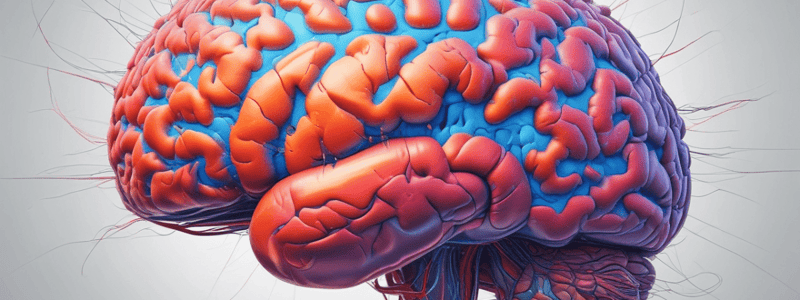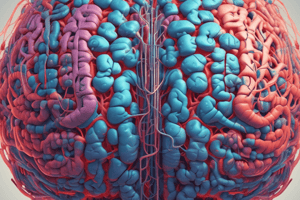Podcast
Questions and Answers
Which of the following is the primary reason that we have a harder time perceiving color in the peripheral visual field?
Which of the following is the primary reason that we have a harder time perceiving color in the peripheral visual field?
- The center-surround organization of retinal ganglion cells
- The small number of cones in the peripheral retina (correct)
- The lack of simple and complex cells in the peripheral visual cortex
- The blind spot in the peripheral visual field
What is the key difference between simple and complex cells in the primary visual cortex (V1)?
What is the key difference between simple and complex cells in the primary visual cortex (V1)?
- Simple cells respond to specific oriented edges or bars, while complex cells respond to more complex shapes and patterns (correct)
- Simple cells are found in the peripheral regions of V1, while complex cells are found in the central regions
- Simple cells have smaller receptive fields, while complex cells have larger receptive fields
- Simple cells receive direct input from the lateral geniculate nucleus, while complex cells receive more indirect input
What is the primary reason that the right half of the visual field is represented in the left cerebral hemisphere?
What is the primary reason that the right half of the visual field is represented in the left cerebral hemisphere?
- The left hemisphere is specialized for processing spatial and object recognition information, which is more prevalent in the right visual field
- The optic nerves from the two eyes cross at the optic chiasm, so information from the right visual field projects to the left hemisphere (correct)
- There are more complex cells in the left hemisphere that are better able to process information from the right visual field
- The right visual field has a higher density of cone photoreceptors, which project more strongly to the left hemisphere
Which of the following is a key function of visual attention mechanisms in the brain?
Which of the following is a key function of visual attention mechanisms in the brain?
What is the primary role of retinal ganglion cells in the visual system?
What is the primary role of retinal ganglion cells in the visual system?
How do simple and complex cells in the primary visual cortex (V1) differ in their receptive field properties?
How do simple and complex cells in the primary visual cortex (V1) differ in their receptive field properties?
What is the primary function of the blind spot in the visual system?
What is the primary function of the blind spot in the visual system?
How do the center-surround receptive field properties of retinal ganglion cells contribute to visual processing?
How do the center-surround receptive field properties of retinal ganglion cells contribute to visual processing?
What is the primary role of the lateral geniculate nucleus (LGN) in the visual system?
What is the primary role of the lateral geniculate nucleus (LGN) in the visual system?
How does the organization of color-sensitive cones in the retina contribute to color vision?
How does the organization of color-sensitive cones in the retina contribute to color vision?
The processes that translate light rays reflected by an apple onto our retinae into the semantic understanding of a red, round, crispy and sweet fruit are simple and fully understood.
The processes that translate light rays reflected by an apple onto our retinae into the semantic understanding of a red, round, crispy and sweet fruit are simple and fully understood.
The centersurround organization of ganglion cells is the primary reason we have a harder time perceiving color in the peripheral visual field.
The centersurround organization of ganglion cells is the primary reason we have a harder time perceiving color in the peripheral visual field.
Simple cells in the primary visual cortex (V1) have more complex receptive field properties compared to complex cells.
Simple cells in the primary visual cortex (V1) have more complex receptive field properties compared to complex cells.
The lateral geniculate nucleus (LGN) plays a primary role in visual attention mechanisms in the brain.
The lateral geniculate nucleus (LGN) plays a primary role in visual attention mechanisms in the brain.
The organization of color-sensitive cones in the retina does not contribute to color vision.
The organization of color-sensitive cones in the retina does not contribute to color vision.
The right half of the visual field is represented in the left cerebral hemisphere due to the primary reason that the blind spot is located in the peripheral visual field.
The right half of the visual field is represented in the left cerebral hemisphere due to the primary reason that the blind spot is located in the peripheral visual field.
Retinal ganglion cells play a primary role in the neural coding and representation of visual information.
Retinal ganglion cells play a primary role in the neural coding and representation of visual information.
Visual attention mechanisms in the brain primarily contribute to higher-level visual processing, such as object recognition and scene understanding.
Visual attention mechanisms in the brain primarily contribute to higher-level visual processing, such as object recognition and scene understanding.
The center-surround receptive field properties of retinal ganglion cells do not contribute to visual processing.
The center-surround receptive field properties of retinal ganglion cells do not contribute to visual processing.
Simple cells in the primary visual cortex (V1) respond to lines, while complex cells respond to more complex visual features.
Simple cells in the primary visual cortex (V1) respond to lines, while complex cells respond to more complex visual features.
Retinal ______ cells play a primary role in the neural coding and representation of visual information.
Retinal ______ cells play a primary role in the neural coding and representation of visual information.
The ______ geniculate nucleus (LGN) plays a primary role in relaying visual information from the retina to the primary visual cortex.
The ______ geniculate nucleus (LGN) plays a primary role in relaying visual information from the retina to the primary visual cortex.
The center-surround organization of ______ cells is the primary reason we have a harder time perceiving color in the peripheral visual field.
The center-surround organization of ______ cells is the primary reason we have a harder time perceiving color in the peripheral visual field.
Visual ______ mechanisms in the brain contribute to higher-level visual processing, such as object recognition and scene understanding.
Visual ______ mechanisms in the brain contribute to higher-level visual processing, such as object recognition and scene understanding.
The primary visual cortex (V1) contains ______ cells that respond to lines and complex cells that respond to more complex visual features.
The primary visual cortex (V1) contains ______ cells that respond to lines and complex cells that respond to more complex visual features.
The ______ spot in the visual field is caused by the absence of photoreceptors where the optic nerve exits the retina.
The ______ spot in the visual field is caused by the absence of photoreceptors where the optic nerve exits the retina.
The organization of ______-sensitive cones in the retina contributes to color vision.
The organization of ______-sensitive cones in the retina contributes to color vision.
The processes that translate light rays reflected by an object onto our retinae into the semantic understanding of that object are ______ and not fully understood.
The processes that translate light rays reflected by an object onto our retinae into the semantic understanding of that object are ______ and not fully understood.
The primary reason that the right half of the visual field is represented in the left ______ hemisphere is due to the crossing of visual pathways at the optic chiasm.
The primary reason that the right half of the visual field is represented in the left ______ hemisphere is due to the crossing of visual pathways at the optic chiasm.
The ______ field properties of retinal ganglion cells contribute to the neural coding and representation of visual information.
The ______ field properties of retinal ganglion cells contribute to the neural coding and representation of visual information.
Match the following visual processing mechanisms with their descriptions:
Match the following visual processing mechanisms with their descriptions:
Match the following concepts with their functions in the visual system:
Match the following concepts with their functions in the visual system:
Match the following statements with their accuracy:
Match the following statements with their accuracy:
Match the following visual perception components with their roles:
Match the following visual perception components with their roles:
Match the following brain's sensory processing structures with their functions:
Match the following brain's sensory processing structures with their functions:
Flashcards are hidden until you start studying
Study Notes
Visual Perception
- The process of translating light rays into semantic understanding of an object is complex and not fully understood.
- The eyes transduce light into neural signals, which are sent to the brain through the optic nerve.
- Foveal and peripheral vision differ in perception (acuity, color, etc.) and eye anatomy (distribution of rods and cones).
Neural Basis of Perception
- Information flow from the eye to the brain:
- Lateral Geniculate Nucleus (LGN)
- Striate cortex (primary visual cortex)
- Higher-level visual areas
- Topographical mapping is present in brain areas involved in visual perception, similar to ganglion cells.
- Feedback connections exist from higher brain areas to LGN.
- Striate cortex has more than 100 times as many cells as LGN.
Visual Processing Hierarchy
- Cells respond maximally to increasingly complex stimuli.
- Higher-level visual areas are increasingly specialized for certain tasks.
- Most functions are processed across different brain areas, making feature binding necessary.
Alternative Research Methods
- Carefully designed behavioral and neuroimaging studies can replace animal studies in some cases.
Important Questions
- Why do we have a harder time perceiving color in the periphery?
- Answer: possibly due to the centre–surround organization of ganglion cells, small number of cones in the periphery, blind spot, or differences between simple and complex cells.
Additional Resources
- Suggested readings: Goldstein chapter 2, Wolfe et al. (2021) Sensation & Perception, chapters 2 & 3.
- YouTube resources: The brain explained in 2 minutes, Hubel and Wiesel's classic experiment, and why the right half of the visual field is represented in the left brain hemisphere.
Studying That Suits You
Use AI to generate personalized quizzes and flashcards to suit your learning preferences.





